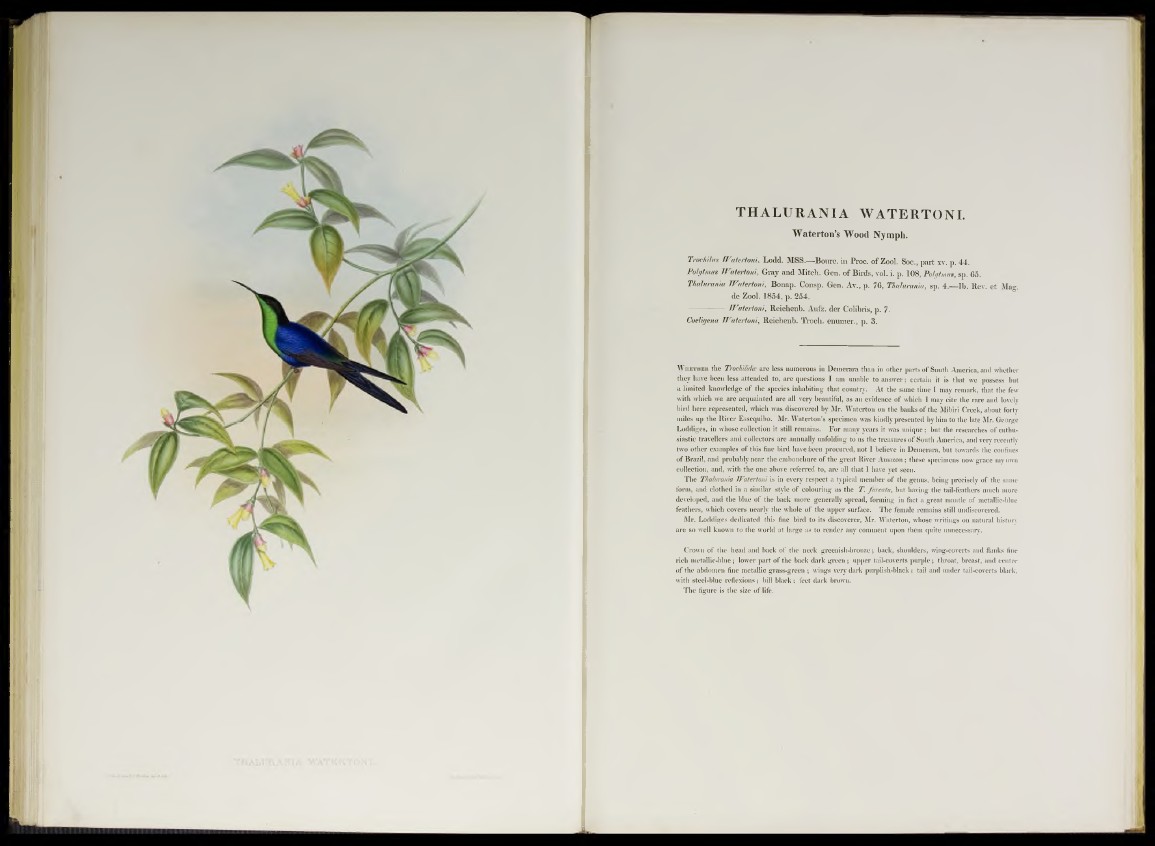
THALURANIA WATERTONI.
Waterton’s Wood Nyraph.
Trochilus Witi-rtmii. Lodd. MSS.—Bourc. in Proc. of Zool. Soc., part xv. p. 44.
Polytmm Watertoni, Gray and Mitcli. Gen. of Birds, vol. i. p. 108, Polytmm, sp. 65.
Thalurania Witertoni, Bonap. Consp. Gen. Av., p. 76, Thalurania, sp. 4.—Ib. Rev. et Mag.
de Zool. 1854, p. 254.
— Watertoni, Reichenb. Aufz. der Colibris, p. 7.
Coeligena Watertoni, Reichenb. Troch. enumer., p. 3.
W h e ther the Trochilidce are less numerous in Demerara than in other parts of South America, and whether
tliey have been less attended to, are questions I am unahle to answer; certain it is that we possess but
a limited knowledge of the species inhabiting that country. At the same time I may remark, that the few
with which we are acquainted are all very beautiful, as an evidence of which I may cite the rare and lovely
bird here represented, which was discovered by Mr. Waterton on the banks of the Mibiri Creek, about forty
miles up the River Essequibo. Mr. Waterton’s specimen was kindly presented by him to the late Mr. George
Loddiges, in whose collection it still remains. For many years it was unique; but the researches of enthu-
siastic travellers and collectors are annually unfolding to us the treasures of South America, and very recently
two other examples of this fine bird have been procured, not I believe in Demerara, but towards the confines
of Brazil, and probably near the embouchure of the great River Amazon; these specimens now grace my own
collection, and, with the one above referred to, are all that I have yet seen.
The Thalurania Watertoni is in every respect a typical member of the genus, being precisely of the same
form, and clothed in a similar style of colouring as the T. Jurcata, but having the tail-feathers much more
developed, and the blue of the back more generally spread, forming in fact a great mantle of metallic-blue
feathers, which covers nearly the whole of the upper surface. The female remains still undiscovered.
Mr. Loddiges dedicated this fine bird to its discoverer, Mr. Waterton, whose writings on natural history
are so well known to the world at large as to render any comment upon them quite unnecessary.
Crown of the head and back of the neck greenish-bronze; back, shoulders, wing-coverts and fianks fine
rich metallic-blue; lower part of the back dark green; upper tail-coverts purple; throat, breast, and centre
of the abdomen fine metallic grass-green ; wings very dark purplish-black; tail and under tail-coverts black,
with steel-blue reflexions; bill black; feet dark brown.
The figure is the size of life.